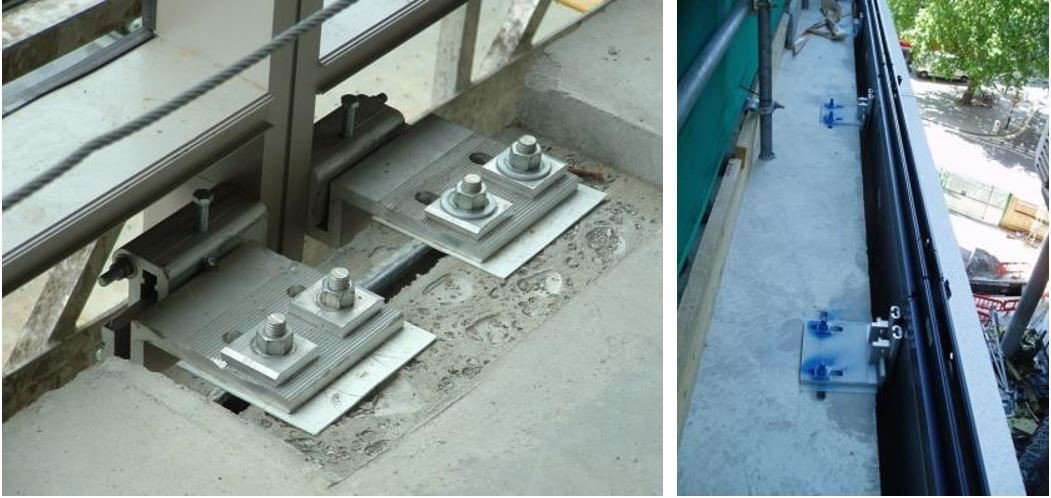The Importance of Anchorage Design in Curtainwall Systems: A Canadian Perspective

Anchorage design plays a crucial role in ensuring the stability and safety of curtainwall systems, especially in high-rise buildings. In Canada, leveraging advanced anchorage solutions like Hilti and Jordahl anchor channels and adhering to CSA A23.3 Appendix D standards is essential for the structural integrity of curtainwalls. This article explores the significance of anchorage design and its integration within curtainwall systems, emphasizing the need for proper coordination between façade engineers and structural engineers.
Understanding Anchorage Design
Anchorage design involves selecting appropriate anchors, determining their placement, and ensuring they can withstand loads and stresses from both the curtainwall and environmental factors. Proper anchorage design is vital for several reasons:
- Structural Integrity: Anchorage systems transfer loads from the curtainwall to the building structure, ensuring the curtainwall remains securely attached.
- Safety: Well-designed anchorage prevents the curtainwall from detaching, which could pose significant safety hazards.
- Performance: The performance of the curtainwall, including its thermal and acoustic insulation properties, relies on a stable anchorage system.
Anchorage Solutions: Hilti and Jordahl
Hilti Anchors
Hilti anchors are known for their reliability and robustness in curtainwall systems. Key features include:
- High Load Capacity: Suitable for high-rise buildings, capable of supporting substantial loads.
- Versatility: A range of anchor types for different substrates and load conditions.
- Durability: Made from high-quality materials, resistant to corrosion and environmental factors.
Jordahl Anchor Channels
Jordahl specializes in anchor channels that offer flexibility and ease of installation. Key features include:
- Adjustability: Allows for adjustments during installation, ensuring precise alignment.
- Load Distribution: Evenly distributes loads across the channel, enhancing structural integrity.
- Compliance: Meets international standards, making them suitable for various construction projects.
CSA A23.3 Appendix D: Anchorage Design Standards
In Canada, anchorage design must comply with CSA A23.3 Appendix D. This standard provides guidelines for designing and installing anchors in concrete structures. Key aspects include:
- Load Calculations: Specifies methods for calculating loads that anchors must support, considering wind pressure, seismic activity, and curtainwall weight.
- Anchor Placement: Guidelines for proper anchor placement to provide adequate support and load transfer.
- Material Specifications: Requirements for anchor materials, including strength and durability.
Coordinating Anchorage Design
Effective anchorage design requires close collaboration between façade engineers and structural engineers. This coordination ensures the anchorage system is seamlessly integrated with both the curtainwall and building structure.
Load Assessment
Façade and structural engineers must work together to accurately assess loads on the anchorage system. This includes wind, seismic loads, and curtainwall weight. Accurate load assessment is crucial for selecting the right anchors and ensuring proper installation.
Material Compatibility
Materials used in the curtainwall, anchors, and building structure must be compatible to prevent issues like galvanic corrosion. Engineers must select materials that work together without degrading over time.
Installation Procedures
Proper installation is essential for effective anchorage. Engineers must develop detailed installation procedures specifying how anchors should be placed, tightened, and inspected. Rigorous adherence to these procedures ensures the safety and performance of the curtainwall system.
Case Study: Successful Anchorage Design in Canadian Curtainwall Projects
Project Overview
A 50-story office building in Toronto used Hilti anchors and Jordahl anchor channels, ensuring compliance with CSA A23.3 Appendix D. Coordination between façade and structural engineers was key.
Coordination and Planning
Regular meetings between engineers ensured thorough planning and execution of all aspects of anchorage design. This collaborative approach ensured accurate load assessments, material selection, and installation procedures.
Installation and Inspection
Detailed procedures ensured correct placement and tightening of anchors. Regular inspections verified compliance with CSA A23.3 Appendix D. Any issues were promptly addressed, maintaining the anchorage system’s integrity.
Outcome
The result was a robust curtainwall system meeting all safety and performance requirements. The curtainwall not only enhanced the building’s aesthetic appeal but also provided excellent thermal and acoustic insulation, thanks to the secure anchorage system.
Conclusion
Anchorage design is a critical component of curtainwall systems, ensuring stability, safety, and performance. In Canada, using high-quality anchoring solutions like Hilti and Jordahl anchor channels, and adhering to CSA A23.3 Appendix D standards, is essential for successful curtainwall installations. Effective anchorage design requires close coordination between façade and structural engineers to ensure seamless integration.
Prioritizing anchorage design and leveraging leading brands and standards can achieve curtainwall systems that meet and exceed expectations. Whether in high-rise or low-rise buildings, anchorage design underpins the entire curtainwall structure, contributing to the overall safety, functionality, and aesthetic appeal of modern architecture.
For more information on anchorage design and curtainwall systems, visit Hilti and Jordahl. Additionally, the Canadian Standards Association provides comprehensive guidelines and standards for construction and anchorage design in Canada.
Need Help? Contact Us Today!
In the USA, anchorage design for curtainwall systems is essential to ensure structural stability and safety. Utilizing advanced anchoring solutions such as Hilti and Jordahl anchor channels is crucial for transferring loads from the curtainwall to the building’s structure effectively. These anchoring systems must withstand various environmental factors, including wind loads and seismic activities, ensuring the curtainwall remains securely attached to the building.
Compliance with local building codes and standards, such as those outlined by the American Concrete Institute (ACI) and the International Building Code (IBC), is vital for the integrity of anchorage design. Proper coordination between façade engineers and structural engineers ensures that all aspects of the anchorage system, from material compatibility to installation procedures, are meticulously planned and executed, providing a robust and reliable curtainwall system for high-rise and low-rise buildings alike.
